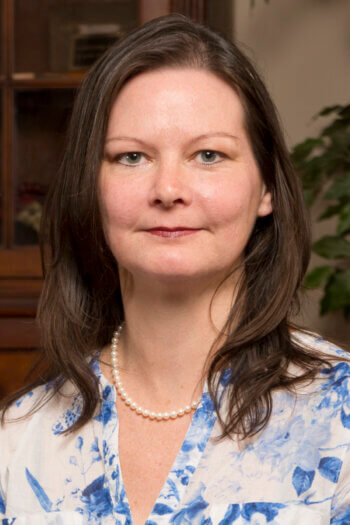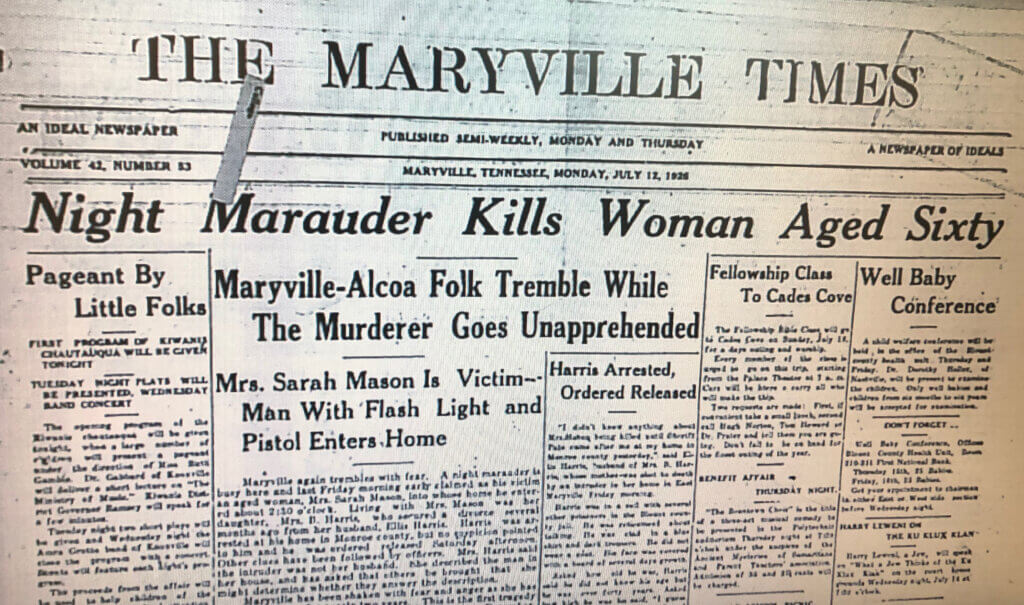Maryville College class revisits unsolved ‘Night Marauder’ murders
March 26, 2021
Between 1919 and 1926, a serial killer at large in Maryville, Alcoa and Knoxville terrified local citizens.
The man was called the Night Marauder because he typically struck at night, leaving murder and assault in his wake. The story was carried by newspapers both locally and in places as far away as Atlanta, Philadelphia, Indiana and Wisconsin with headlines such as “Maryville and Alcoa folk tremble while murderer goes unapprehended.” The killer even sent a letter to the Blount County sheriff, taunting him, saying, “You are never going to catch me.”
William Sheffey, a suspect with ties to Maryville College, was arrested on five counts: two for the murders of Luther Wells and Clyde Poe; two for assaults on Ada Wells and Flora Poe; and one of breaking into a third home. However, after three trials on one charge, the murder of Luther Wells, with no conviction, all charges were dismissed. He left Blount County for California soon after.
This long-forgotten case may have been forever lost in the mists of time had Maryville College history professor Dr. Nancy Locklin-Sofer not stumbled across a short reference to it while preparing a new class, the History of Murder. In this class, students are exploring facets of murder, including vigilante justice, the erasure of victims, hate crimes, political assassination, serial killers and manslaughter, as well as tracing the emergence of the criminal justice system along with trial law strategies.
True crime
Although her specialty is 18th-century France, in researching a legal history project for her recently published book, Murder, Justice and Harmony in an Eighteenth-Century French Village, Locklin-Sofer came across a court dossier about a 1718 murder trial in France and discovered a whole body of literature on true crime. When her students expressed an interest in a class on the history of murder, she readily agreed.
“That was the inspiration for the class,” she said, adding, “I am very lucky to be at a place like Maryville College. I have the freedom where, if I know students want to learn about something, I can usually do it.”
Maryville’s serial killer was rediscovered after Locklin-Sofer saw a snippet of a story from 1926 on The Daily Times archives page headlined, “Night Marauder kills woman age 60.” Two women, a mother and her recently divorced daughter, were attacked and the mother shot. Since the Maryville Times and Maryville Enterprise have not been digitized and online, Locklin-Sofer went to the Blount County Public Library to look up the story on microfilm. “That’s all I was looking for,” she said.
“Stroke of luck”

She calls it a stroke of luck that she had to find the information in this way, because she had to scroll through the whole roll of microfilm.
“In doing that, I would see, ‘Night Marauder Strikes Again,’ ‘Another Night Marauder Killing,’ ‘Man stands trial for five counts in Night Marauder Killing,’ and I could not believe the scope of this thing.”
She began gathering information from numerous sources, including Reference Librarian Brennan LeQuire, Blount County Genealogical and Historical Society President Tim Walker and Maryville College Archivist Amy Lundell ’06. She also spoke with Knoxville attorney Wayne Kramer ’74, a graduate of MC, whose grandfather, Russell Kramer, defended Sheffey. Unfortunately, none of the elder Kramer’s documents have been located, and neither have any of the Blount County Court records on the case.
By another stroke of luck, Tim Walker asked Alcoa historian, Circuit Judge David Duggan, if he could shed any light on Sheffey’s case. Duggan did have information—a 4-inch-thick stack of papers given to him several years ago by the granddaughter of V.J. Hultquist, construction supervisor for the Aluminum Company of America and later, city manager for the city of Alcoa. Duggan had glanced through the papers several times and saw they had to do with a series of murders supposedly linked to one person, but he didn’t study them in detail. The name “Sheffey” stood out; a beloved Alcoa teacher and principal was Josephine Sheffey Irwin. Duggan later discovered she was the sister of the accused murderer.

The materials included old newspapers, correspondence, transcripts of witness interviews, reports of a private investigator and a summary of the murders. “So, I knew the kinds of things I had, but I still didn’t realize the significance of it,” Duggan said. That is, not until he spoke with Locklin-Sofer, who copied the documents and is now using them in her class.
Duggan believes Hultquist, who believed Sheffey was guilty, was involved because of Sheffey’s connection with Alcoa.
“At one time, Sheffey was employed by the company, and some of the criminal activity took place in Alcoa,” Duggan said, adding, “The summary lists more than 40 murders that somebody thought had similar characteristics. But that’s not to say Sheffey was necessarily a suspect in all of them.”
In the dark
Locklin-Sofer said the typical Night Marauder crime involved attacking homes that did not yet have electricity.
“He would get to know the household well enough that, according to a couple of survivors, he would manage to get into their room and remove all the matches from next to the lanterns before he would start doing anything so that there was no way they could turn the lights on,” she said. “Then, if it was the case of a young couple, especially, he would shoot the man, and while the man bled out on the floor, he would attack the wife, assault her. In some cases, if the women fought back or tried to get away or screamed, he would shoot them, too.”

William Sheffey had been tried and acquitted in 1915 in Sevierville over the death of a young woman in a very similar case.
“In fact, a witness in the 1915 Sevierville case saw a man leaving the area who claimed his name was J.J. Emery, and that was the name signed on the letter to the sheriff,” Locklin-Sofer said. “So, something connected the Sevierville case to the Maryville, Alcoa and Knoxville cases, and to a lot of people, it seemed likely to be Will Sheffey. After 1915, when he was acquitted and World War I later started, he served in the military. After he comes back, his mother has moved to Maryville and lived right on College Hill, near the Maryville College campus.
“He had a lot of connections to the College,” Locklin-Sofer continued. “The Proffitts were character witnesses, psychology professor (Jasper) Barnes was for the defense team. One of Sheffey’s sisters was on staff, and one of Sheffey’s brothers got a math degree and then taught math for a while.”
Not everyone at the College was convinced of Sheffey’s innocence. The journal of Samuel Tyndale Wilson (1878), MC alumnus and the College’s president from 1901 until 1930, notes that Sheffey was a “wicked creature.”
Remembering the victims
Leigh Ann Brewington ’21, a Maryville College senior majoring in history with a minor in psychology, said she enjoys the combination of true crime and historical documentaries in the History of Murder class.
“I had no idea that we would be going over a real case that happened right in our community,” she said. “I’ve grown up in Maryville my whole life and had never heard of it! I enjoy looking at the old documents and learning the facts behind the case.”
She said the class has been compiling a timeline of the murders, along with a timeline of William Sheffey. “We’ve also been looking at other murder stories in the case to get some context for the murders that happened in Maryville.”
Myndalynn Word ’21, a senior majoring in English literature and minoring in writing communications, said, “One of our first assignments was to analyze a primary source from the Night Marauder case. I got to take a deeper look at the Emery letter. This letter was published in multiple newspapers in the area, and it came from the murderer himself. Of course, a lot of suspicion was that Sheffey wrote it, but that was never proven. Either way, this letter admitted to the murders and literally listed all of the murderer’s victims at the end of it. … Some of the details are just creepy! He said that he could only kill a woman if she would scream for him. In fact, he stated that he didn’t like Maryville women as well because they wouldn’t scream for him.
“Nowadays, the murderers are idealized, and I think that sends the wrong message,” Word continued. “I understand that their stories are interesting, but they are literally the bad people. The innocent victims should be the real heroes of the story. I just think it is super nice that Dr. Locklin-Sofer has us focus on the victims.”
Locklin-Sofer said, “You don’t ever want to lose sight of the human tragedy, the people who are lost. I had wanted to make sure my students were focusing on the survivors, especially like Flora Poe. I want to know her story and all of these others.”
Community engagement
Locklin-Sofer said she would like to see a book result from the collaboration with her students and others who would contribute information, since true crime is such a popular genre.
“Besides some of the academic pieces setting up the topics in my class, some of the legal cases and criminal justice sources, we’re also reading these kinds of books, things written by journalists and novelists that are historical true crime. I feel like this has the makings of a trade book in which the students and even community members would be listed among the contributors. The acknowledgements page alone will be a love letter to the local history community.”
Anyone with information to share may reach her at nancy.locklin@maryvillecollege.edu.
Story written by Linda Braden Albert for Maryville College